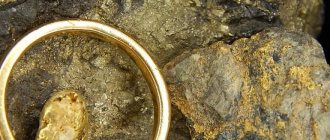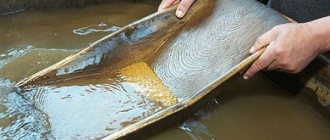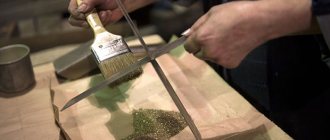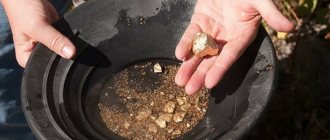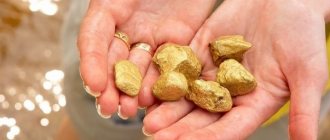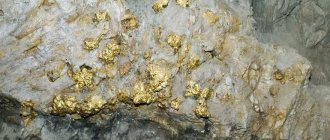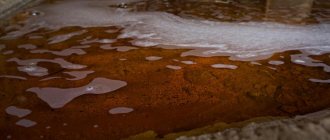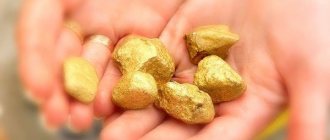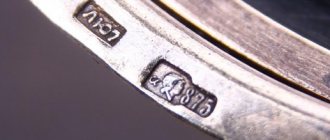To get gold, people use different tricks. Since the precious metal is rarely found in nugget form, several operations must be carried out before pure gold is extracted from the soil. Therefore, the question of how to extract gold from sand becomes relevant, especially for illegal miners.
The sand contains gold particles. They are usually small and found in the form of scales or grains. Sand, which contains the precious metal, can be found everywhere, but most often it is found on the banks of rivers, near alluvial placers. The material cannot be used, processing occurs only on an industrial scale, but prospectors are trying to get rich on their own and extract at least a little gold.
Mining gold from sand
A little history
If we go back to the times of Ancient Rus', it is reliably known that lands containing gold were not discovered at that time, even despite the fact that the territory of the state was quite vast. Ruler Ivan III was obsessed with the goal of finding the noble metal and even invited specialists from distant Italy for this purpose. But to his regret, only a small piece of gold was found, which was only enough to make a small cross.
Read also: Year of manufacture of the car by VIN code
The next seeker was Ivan the Terrible. For the sake of gold, he even conquered Siberia with the help of a huge army, but he never achieved the expected result. The same fate befell all the other rulers of Ancient Rus'. But the turning point in the history of gold mining was the coming to power of Peter I. It was under the power of this ruler that the first items of clothing and jewelry that contained gold and precious stones began to appear.
The first gold nugget was mined in 1945 by a Russian peasant from the Urals who was building a house on the river bank.
While digging a hole, he found golden grains of sand. The peasant immediately showed the find to his friend, who was also a silversmith. The master confirmed that the nugget was genuine. Experts arrived at the place where the grains of sand were found and began further searches. But unfortunately, they left with nothing. And only two years after the discovery of the deposit, a decision was made according to which it was necessary to continue the search and dig a mine. This decision turned out to be more than successful.
At the bottom of the dug shaft, a large amount of gold reserves were found, which marked the beginning of larger-scale mining of the metal.
Magical qualities of the stone
Back in the Middle Ages, the extraordinary magical properties of this mineral were described. It is especially needed for those who lack luck and fortune. Energy allows you to achieve success in any endeavor and gain wealth. Thanks to it, the owner of the stone becomes more energetic and active.
Another wonderful ability of aventurine is the awakening of intuition and the manifestation of talents. It gives inspiration and recognition to creative people and helps them overcome a creative crisis.
Contrary to popular belief, the green variety is not a talisman for swindlers and card players. The mineral provides protection to lovers, protects their feelings and helps preserve love for many years. The green mineral is a symbol of family well-being. He is able to protect from damage and envy. A decoration with such a stone can be hung over a child’s crib to protect him from fears and illnesses.
How can you mine Au?
To do this you will need the following equipment:
- The tray is better if it is blue: against this background, the yellow grains become especially noticeable.
- The gateway is the second stage of treatment from sand and other impurities, as it has special inserts on which heavier Au settles, and everything else is washed out.
- Tools – gold is mined in cracks using a pick or pick.
- Miniature gold dredge. Lightweight portable floating gold mining equipment. A budget option that makes it easier to search for aurum in rivers, it passes through up to 10 cubic meters of water per hour. With its help, panning for gold will be easier.
Where is the best place to mine gold?
Golden sand is obtained by washing out grains from rock. Therefore, there is more of it in the rivers that flow past the deposit. Most often these are mountain rivers with an average flow, sufficient to wash silt out of the tray. With the industrial approach, geological exploration is carried out. True, it is expensive.
You can contact residents of surrounding communities for help. Even if they don't point to the location, at least it will be clear whether the desired metal is there as such. Checking for availability is carried out in several stages as you move upstream. Even if someone had worked before, this does not mean that the gold particles were not deposited again by the current.
Licensing of mining activities from a gold mining company
On the territory of Russia, it is only possible to legally mine gold if you have an agreement with a licensed enterprise or under a personal license, but then the miner must be registered as an individual entrepreneur. In the second case, a person will be able to mine precious metal in a small free area for five years.
What kind of illegal mining will happen? What the law says
Gold mining by individuals is prohibited on the territory of our country. Violation is subject to administrative liability, a fine of 3 to 5 thousand rubles and confiscation of precious metals. Criminal liability arises only if particularly large-scale illegal production is proven.
Illegal mining: what threatens “black” miners
The legislation provides for two types of liability if gold is mined illegally. The Administrative Code provides for a fine of 3 to 5 thousand rubles. Equipment will not be confiscated. But this is only if the volume of precious metal mined has a cost of less than 1,000,000 rubles. Otherwise, the Criminal Code comes into force, since the amount is especially large. But criminal structures and competitors pose a greater danger to illegal immigrants working illegally.
Practice has shown that they, without a twinge of conscience, hand over “their brother” to law enforcement agencies. They do not receive any profit. But they take away the equipment, space, etc. There are many cases where people were killed in remote parts of the country. There is a place for racketeering in this area. The fact is that a “black miner” cannot contact the police, since he himself works illegally.
How to wash by hand
To wash goldfish with your own hands using an ordinary tray, you need a round or rectangular trough up to 40 centimeters in size and a sieve. If, after washing, at least one grain remains in the sieve, the miner can be congratulated: the placer has been found. If not, you need to try further. Of course, such washing requires enormous patience.
The principle of operation of the mini-dredge is the suction of sand and small particles of pebbles from the bottom with mechanical separation of gold from the rock. The disadvantage of using this device is that it creates a lot of noise, attracting the attention of conservationists. To mine precious metals in this way, I strongly advise you to first purchase a license, otherwise you will face problems with the law.
Romance or earnings
Prospectors are divided into two categories. Some people need vivid impressions, privacy, excitement, and earnings come in the background. Others live by it. Naturally, both of them dream of finding the biggest nugget. And such cases do happen. It is important to know how to search correctly. You immediately need to determine what the earner wants:
- Sand deposits . Sieves are used, washing is carried out more thoroughly, and the water pressure is set more powerfully. The upper layers of bottom sediments are washed.
- Nuggets . Only large sieves are used, the washing is less active, so as not to wash the nugget into the river. Soil lying at a depth of more than 0.3 meters is subject to washing.
The difficulty is that manually selecting bottom soil to a depth of 30 cm to 1 meter is physically difficult. One tray is not enough. You need a tool that allows you to scoop up rock. Pumping equipment and mechanization are used, which also costs money.
Profitability and laws
Legislation prohibits the extraction and sale of technical gold. To mine it, you will need to obtain a private miner's license. You can hand over the mined gold to the state, but it pays very little for it - about 20 kopecks per milligram. Trying to sell it to someone else can result in punishment under the Criminal Code.
Most likely, you will not come across gold on an industrial scale, since the richest deposits have long been occupied by gold mining companies, and if you mine gold on their territory, you can get into trouble. Other places are not so rich in gold; for example, in the Moscow region, the soil contains 20-60 milligrams of gold per cubic meter of rock. Accordingly, it will take several days to extract a gram of gold, and you will have to work hard, but you will then receive about two hundred rubles for it. But most local miners still pursue other goals. They do this not to get rich, but for pleasure. There are even competitions for such “treasure hunters.”
Useful tips
To save time and wasted energy, follow these recommendations:
- Take a sieve with you. It can be installed on a tray to filter larger rocks from smaller ones, which will significantly speed up the work of sand washing.
- You can purchase a special tray on the Internet. It can be metal or plastic. For beginners, it is better to use the second one, as it does not rust and has less weight. If it is not possible to purchase one or you have not yet decided whether you will do this on an ongoing basis, use a regular plastic basin.
- Select a part of the river where there are large rocks or where a tree has fallen into the water. Your work will be much easier if you have the opportunity to sit.
- It is best to choose a place with optimal flow. It should not be too fast so that it disturbs you, but not too slow so that it washes sand out of the tray.
- The minimum depth of the river in the place you choose must be at least 15 centimeters. If the depth is shallower, there is a chance that the water will have too much debris and leaves or will be dirty.
- Go to where, according to local residents, gold was found. The probability of finding gold there again will be much greater than in another place, especially if large nuggets were found, since this indicates a slight removal of the deposit.
- Circular movements with a special tray should be done carefully, as this creates centrifugal force and large particles may fall out of your tray.
- If you haven't been able to find gold, don't despair. Try again or look elsewhere for your efforts.
- Look on the Internet or in other literature to see what loose gold looks like. This way you can easily detect it and distinguish it from something similar to it, such as mica.
- Don't be fooled by pyrite. Pyrite is a mineral that consists of sulfides and iron, and can be similar in appearance to gold. It can be easily distinguished by this characteristic - it forms small cubic crystals. Mined gold looks different. It looks like grains, scales or small lumps of strange shape.
One option for making work relatively easier is to mine gold in winter. This makes the work somewhat easier if you know exactly where it is kept, since at this time it is much more convenient to move along mountain rivers, for example, using skis.
Sand panning is considered one of the easiest ways to mine gold. It is profitable to do this on an industrial scale; privately, it is unlikely that you can get rich from this, at least legally. The main advantage is for people living near high mountains and who know the area. They may well make it a profession or their main source of income. But for others, there is a consolation prize - the excitement of the thought of finding a weighty nugget.
Tray - equipment for beginners
Washing trays are used for taking samples, but those miners who have not yet mastered all the intricacies of searching use the tray as a means of extracting gold. Professionals work with a metal detector because up to 100 g of gold can be collected in a week of panning. But they are still used today. The choice of tray determines the efficiency and speed of work. It is inconvenient to look for gold with a metal tray. There are greasy hand marks on it; they can only be removed by annealing the tray. The metal is corrosive and cannot be tested with a metal detector or separated from magnetite and gold. All the negative aspects of a metal tray are completely absent from a plastic product, and a green tray is an ideal product in which gold flecks are very clearly visible.
In searches, trays with a diameter of 15-40 cm are used, but a tray with a diameter of 40 cm will weigh approximately 10 kg in use. Therefore, the best option would be a tray with a diameter of 35 cm. In addition to the trays, you need to purchase a plastic sieve (mesh size 12 mm). Rinse should be 300-500 m higher from the river mouth. A good sign would be if at least 1 piece of gold gets into the tray, but if nothing is found during washing, this is not a sign that the stream is hopeless. If there are large nuggets in it, then there will be very few small gold pieces.
Modern methods of alluvial gold mining
Ordinary gold miners search for and develop deposits the old fashioned way. Since ancient times, this labor-intensive process looked like this. A person scoops up the bottom sediments of a mountain river into a special tray and thoroughly washes them down to the smallest grains under a stream of water. Gold is heavy, and its pieces settle on a special grid, while other, less dense particles are quickly washed out of the tray. This grille has a corrugated vinyl covering, which traps the scattering.
In ancient times, instead of these cunning devices, prospectors used ordinary sheep skins. It was just that the gold flakes got stuck in the wool instead of the ribbed vinyl coating like they do now. Even the ancient Greeks went hunting for gold with sheep's fleece. Actually, this is probably where the legend of the Golden Fleece came from.
The second type of this method requires not only great care, but also additional physical effort. Particles of alluvial gold can lie not only on the surface of the bottom of a mountain river, but also in deeper bottom layers. Then the miners dig out the rock with a shovel and wash it in the same tray. But in this case, they still have to grind large pieces into sand so as not to miss precious grains of sand. It's hard work and the "catch" is not as large as in industrial gold mining, but there are still many hunters every year who want to try their luck.
Prospectors primarily mine placer gold in the summer, since standing in icy water in winter and manually sorting through the silt seems an almost impossible task.
But rare units also work in winter, since there are a number of advantages at this time. In winter, the water level in the rivers drops, and it is easier for a person to see particles of gold on its banks. In the cold season, the tools they take with them are not a tray for washing the sludge, but special tools that could be used to beat off frozen pieces of gold.
Gold mining companies also do not stand aside from the extraction of placer gold. They extract it in the waters of seas and rivers using dredges. These are stationary or floating installations with serious technical equipment on board. This technique collects bottom soil. In this case, the depth of intervention in the soil varies from five to fifty meters.
The dredge has all the necessary equipment, which is used to wash the sand and bottom rock raised on board. Large-scale dredges have a staff of ten people, but small devices can be managed by only one manager.
Dredges are divided into:
- marine;
- continental.
Marines can move through the water themselves, or they can be pulled to their destination by a tug. And continental ones, installed on rivers, are created on the basis of flat-bottomed vessels. But for them to operate effectively, there must be a high water level in the river. When it becomes shallow, work is suspended.
How to look for gold correctly
Finding gold is a very long process that can last for years. It is unlikely that in the first days of searching the digger will find something worthwhile. In order to somehow speed up this process and make it more productive, it is recommended to study a large amount of literature that can teach you how to properly organize your searches.
It has already been said that gold is found in quartz strata. To detect them, you need to pay attention to certain signs that are characteristic only of such deposits.
Cost of production and laws
To search for precious metals legally, you need to obtain an appropriate license, valid for 5 years. To receive it, you need to register as an individual entrepreneur or register as a legal entity.
To engage in professional mining, it is advisable to have equipment for extracting sand from the depths of a reservoir, where the concentration of metal is greater. Only the state is allowed to sell jewelry. There are penalties for the illegal sale of gold to private individuals.
Profitability calculation
For mining to be economically profitable, you need to find a place with a high concentration of metal grains in the silt. Otherwise, there is a risk of wasting a lot of time, earning 50-100 rubles a day. For example, in most rivers near Moscow, a maximum of 0.6 g of gold is produced from 1 m3 of sand using manual technology. The profit from such production will be small.
Self-extraction methods
Particles of precious metal fall into river sand as a result of erosion of gold-bearing rock. Finding a solid nugget, given the scale of industrial search, is unlikely in our time. Sludge washing is now the main method of gold mining.
You can do it yourself, knowing the places with high concentrations of precious metal and how to separate it from sand at home.
Manual flushing
The method is based on the fact that gold is heavier than all other particles contained in the sludge. Due to this, the metal is separated using a special tray or bag, settling at its bottom. Grains of base metals (the so-called concentrate) are removed using a magnet.
Amalgamation
Mercury particles capture grains of precious metal, “wet” it, separating it from the bulk of the soil. After this, the sludge is removed, and the mercury is evaporated, drawn out with a plastic syringe, or dissolved in nitric acid.
The technology is dangerous for use at home. Inhaling mercury vapor is harmful to the human body. It is necessary that during amalgamation the room is well ventilated. It is advisable to use a mask and protective gloves.
Cyanidation
The method is used when the content of the element in the sand is very low. For purification, hydrocyanic acid is used, which is even more toxic than mercury. Inhalation of cyanide vapor causes immediate death. To prevent the formation of toxic fumes, the pH of the solution is artificially increased using alkali.
Which way is better
Cyanidation and amalgamation are quite dangerous manipulations to use at home. When washing in small volumes, the manual method is better. It does not require the use of chemical reagents; metal separation occurs mechanically.
Identification of deposits in nature
In the era of free access to any information, it is not difficult to understand how to identify gold in a stone. But before that, you need to consider the list of the most promising places in which such a metal is likely to be present. Theoretically, particles of gold can be present in a wide variety of stones, but their quantity is so minute that it is not of particular value. If you want to engage in more serious mining, you need to count on luck and follow the principles of identifying deposits.
A small amount of the precious metal is found in sea water . Experts say that if all gold reserves are removed from the waters of the World Ocean, their quantity will reach 10 billion tons. The figure looks shocking, but modern science does not know any methods for extracting metal from the hydrosphere.
In its pure form, gold is extremely rare, especially when it comes to stones containing this noble metal. In most cases, yellow treasure is found along with various impurities that need careful processing. It is possible to find pure material in large quantities in quartz formations. Such formations are constantly exposed to wind and rain, which causes their destruction. As a result of this process, a single piece of gold nugget is formed.
Natural reserves of gold are also contained in the following deposits:
- Eluvial.
- Residual.
- Bottom.
- Terraced.
Residual deposits are observed near the vein itself, which was under physical or chemical influence. The eluvial type is found directly at the foot of the mountains.
Terrace deposits can be identified at the bottom of reservoirs, usually rivers, which erode the earth, forming an additional bottom. The old bottom layer turns out to be above ground level, which makes it look like a kind of terrace. And the older this terrace, the higher the likelihood of successfully identifying a large number of valuable reserves. Sediments end up at the bottom through precipitation, and under the influence of rain and currents they are washed ashore.
Preparatory processes for the enrichment of gold-bearing sands.
A necessary condition for preparing gold-bearing sands for beneficiation is the release of their granular part from clay and sludge components (disintegration) and the removal of large fractions of waste rock (screening).
The efficiency of disintegration of gold-bearing sands depends on:
- degree of washability and granulometric composition of gold-bearing sands;
- specific consumption and method of water supply for disintegration;
- the intensity of the impact of mechanical devices of the disintegrating machine or apparatus;
- duration of stay of the material in the disintegrating machine or apparatus (specific productivity of the apparatus);
- designs of disintegrating machines and apparatus;
- the degree of preliminary preparation of the material before disintegration (drying, pre-mixing, saturation with chemical solutions).
By design, disintegrating machines and apparatus are divided into:
- drums (drum screens, scrubbers, mills);
- auger (trough and sword washers);
- vibration (flat vibration, vibration-drum);
- hydraulic (pipe hydraulic elevators, hydraulic cradle elevators, sluices).
How to use a gold pan
Using a tray, precious metal is mined in the traditional (manual) way. To do this, sand is lifted from the bottom of the reservoir and placed in a tray. The best depth for work is 15 cm. Then the tool is immersed in water and circular movements are performed.
The sludge is washed, leaving light particles that do not contain metal. Final purification with separation of heavier fractions can be carried out at home. How to extract grains of gold from sand is described above.
Next, watch a visual video of one of the methods of gold mining:
Animation diagram of the operation of the EG installation for disintegration
To confirm the effectiveness of EG technology in comparison with classical methods, a number of experiments were carried out on the enrichment of high-clay gold-bearing sands.
The starting material of the sample was subjected to processing with EG technology, which consists in washing the clay from the mineral component of the sample. In addition to EHT, the disintegration of the clay fraction was carried out in a scrubber drum and manually under running water. After disintegration, the resulting material was separated on a 2 mm sieve, releasing sand (+2 mm) and clay (-2 mm) fractions. The clay fraction was further enriched on the SKL-2 concentration table.
After separating the sample into sand and clay using electro-hydraulic technology, the resulting sand fraction was sent for chemical analysis using the atomic adsorption method. The gold content in the sands is 0.51 g/t. Given that the average gold content of the processed high clay sands is 0.2 g/t, most of the gold remains in the sand and is available for further beneficiation.
Results of chemical analysis of washed sand
| Product | Weight, gr. | Au content, g/t |
| Sand | 1446,79 | 0,51 |
Next, experiments were carried out on the gravitational enrichment of the clay part of the sample using the SKL-2 concentration table. According to the results of the gravity experiment, gold recovery in the concentrate is 2.47% with a content of 0.15 g/t in the gravity concentrate.
Results of gravity enrichment of clay fraction
| Product | Exit, % | Au content, g/t | Au recovery, % |
| Gravity concentrate | 0,67 | 0,15 | 2,47 |
| Tails of gravity | 99,33 | 0,04 | 97,53 |
| Total ore: | 100 | 0,04 | 100 |
The obtained indicators of separation of the clay component from the granular part of the sample confirm the effectiveness of the EG technology. As a result of processing the material with EHT, the main part of the gold was concentrated in the sand fraction. The clayey part is not suitable for further gravity enrichment.
Also, together with the disintegration of high-clay sands using the EG technology, experiments were carried out in parallel on washing the clay fraction in a scrubber drum and manually.
Risks and prospects of home gold mining
When mining gold at home legally, you have to buy specialized equipment. These are pumps, sieves, gutters, etc. If we are talking about processing, then you will need reagents, laboratory equipment and furniture. Not every businessman is able to recoup his expenses.
There are risks, as in any business. However, interest in mining activities has not waned for centuries. The reason lies in the fact that this metal has never fallen in price. Minor fluctuations in the precious metals market occur, but the cost per gram becomes higher and higher as a result. No inflation is scary. This is the main difference between gold reserves and foreign exchange reserves.
How to obtain a mining permit
To obtain a license, you must form a legal entity and have special equipment for washing. The activities of legal miners are checked by labor safety inspectors and environmentalists. Obtaining a mining permit is associated with financial costs, so it is necessary to calculate whether such a license will pay off.
The cost of a permit for gold mining at home will range from 10 to 100 thousand rubles, and the state duty for its initial registration costs 7,500 rubles.
